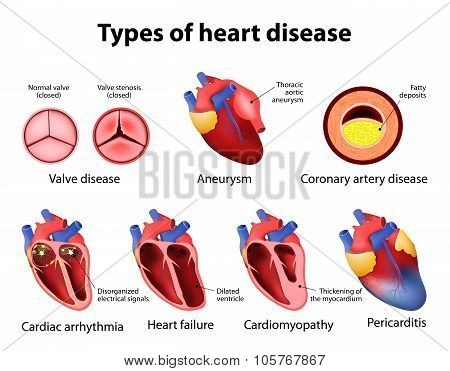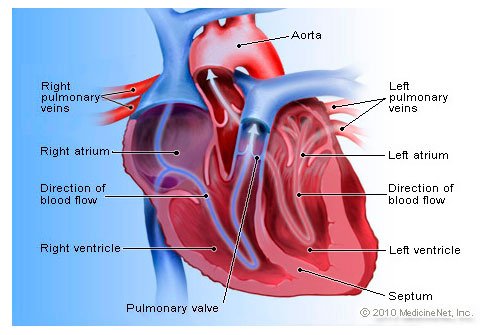
There are several types of cardiovascular diseases
Discover the different types by learning about the various signs, symptoms, and conditions associated with these diseases. Know more about some of the more common conditions.
Coronary Heart Disease (CHD) Coronary artery disease is the name given to a number of conditions that affect the cardiovascular system. These include atherosclerosis, which affects the walls of the arteries that supply the heart with blood. Other conditions include atherosclerotic heart disease, a narrowing or hardening of the arteries; coronary angina, the pain associated with heart failure; peripheral arterial disease, narrowing of the arteries supplying the extremities and affecting the legs; thrombosis, a clot forming within the artery; and cardiac arrhythmia, abnormal rhythms associated with the heart. Some of these conditions may cause symptoms or complications, and others can be fatal. Learn about the signs, symptoms, and conditions associated with all these different forms of cardiovascular disease.
Coronary Heart Disease (CHD) is the most common cardiovascular disease affecting Americans. About one in every five Americans is estimated to have CHD, with men far more likely to develop the disease than women. In the United States, about half of all people who die from a cardiovascular disease do so because they were suffering from CHD. In fact, CHD has been a leading cause of death in America since at least 1960.
There are several signs that point to the presence of coronary heart disease. People of all ages can develop atherosclerosis. The main symptoms are chest pain, discomfort, or discomfort around the upper chest, especially in the area between the breastbone and the upper arm. People with this condition should be examined by a physician as soon as possible, even if they think they are not at risk of developing coronary heart disease. In addition to these symptoms, people with atherosclerosis should also experience a change in their lifestyle if they already have it. For example, if they are smokers or eat high-cholesterol foods, then they should avoid such food until they have had a coronary heart attack or have had a heart attack in the past.
If someone has had a heart attack, they should try to avoid triggers or unhealthy situations that may increase the likelihood of another attack. It may help them to maintain a healthy diet and to increase their exercise.

Heart attack symptoms, while not immediately life threatening, can cause more pain and complications
A doctor should take an electrocardiogram and do coronary artery stress tests. Once symptoms start to appear, these tests should be repeated as soon as possible.
Atherosclerosis occurs when the walls of the arteries harden, and when they do this, they often begin to form calcifications. These calcifications are caused by fatty deposits that can cause damage to the heart muscle and to the walls of blood vessels. Atherosclerosis can lead to hardening of the arteries that can block the flow of blood from the heart.
Sometimes, patients with coronary heart disease have heart palpitations, which are sudden fluctuations in heartbeat rate and rhythm, chest pain, and dizziness. Symptoms of CHD in the family include palpitations and fatigue, frequent urination, a feeling of chest heaviness or pressure, difficulty breathing, and breathlessness, difficulty swallowing, abdominal pain, and nausea. Some people may also experience irregular heartbeats and shortness of breath.
The symptoms of CHD in the family are typically more pronounced and last longer in those who have the disease than in those who do not. If someone has been diagnosed with this disease, they should keep a daily journal, called the Stokes Index Cardio-Respiratory Index, or the Stokes Score, in order to monitor any changes in their health. If they are experiencing these symptoms, they should seek medical treatment, particularly if there is no obvious change in their daily habits, which might indicate that they are not at risk for coronary heart disease.
Heart disease, whether caused by genetics or some other condition, affects thousands of people every year. However, due to the very large population, the disease is not diagnosed in a significant number of people. or do not realize that they have a disease. This is where a doctor or family member can play an important role. To diagnose someone with coronary artery disease, they will take medical history, perform certain tests, investigate their symptoms, test their family members, and ask them questions.
In many cases, if a person is diagnosed with a heart condition, family members can offer information and support. They may also advise family members to improve their diet or take Wellcard vitamins or supplements to improve the patient's overall health. People with this type of heart disease can become very active and lead healthier lives. However, first of all, the doctor must make the correct diagnosis of the disease.